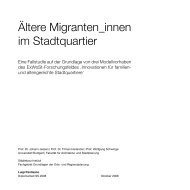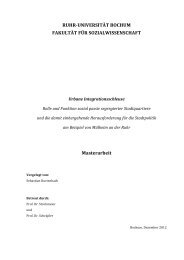- Seite 1: ARBEITSBERICHTE Geographisches Inst
- Seite 5 und 6: INHALT DES BANDES Vorwort .........
- Seite 7 und 8: Vorwort Die Quartiersforschung hatt
- Seite 9 und 10: cen und Grenzen der Integration auf
- Seite 11 und 12: Planungsebene, die ja unser Alltags
- Seite 13 und 14: eleuchtet, andererseits wird das ne
- Seite 15 und 16: Die fortschreitende Ausdifferenzier
- Seite 17 und 18: 3. VORSTELLUNG DES NIDS Entstehung
- Seite 19 und 20: dieses Modell auf jegliche Art von
- Seite 21 und 22: Allerdings sollte dieser Punkt, mei
- Seite 23 und 24: müssen Aufgabe des Staates bleiben
- Seite 25 und 26: SEMINAR BLOG quartiersforschung.de
- Seite 27 und 28: Neighbourhood Branding (NB) Was ist
- Seite 29 und 30: New Urbanism: Nostalgically Re- ins
- Seite 31: planners, economists, citizen activ
- Seite 35 und 36: together in community. But he also
- Seite 37 und 38: (Bond/Thomson-Fawcette 2007 pp 462-
- Seite 39 und 40: though there are some successful de
- Seite 41 und 42: REFERENCES Antoine, T.J. (2007): Ma
- Seite 43 und 44: SEMINAR BLOG quartiersforschung.de
- Seite 45 und 46: vorgesehen, die teilweise als selbs
- Seite 47 und 48: Im Diskursgemenge der Integra- tion
- Seite 49 und 50: zu Gleichstellung, Rechten und Disk
- Seite 51 und 52: ExpertInnen-Interviews und anderen
- Seite 53 und 54: kritisch betrachtet wie „Integrat
- Seite 55 und 56: erweitert. Diese sollen nicht räum
- Seite 57 und 58: • Förderung der Kommunikation un
- Seite 59 und 60: dungspunkte dieser Position kann si
- Seite 61 und 62: Politische Arbeit, soziale Bewegung
- Seite 63 und 64: Schulz, S. (2010): Wechsel: "FDP ze
- Seite 65 und 66: geprägten Quartier als Integration
- Seite 67 und 68: Das Quartiersmanagement und ihre Pr
- Seite 69 und 70: angeregten BewohnerInnen und Partne
- Seite 71 und 72: en können VertreterInnen aus gebie
- Seite 73 und 74: Phase III - Öffentliche Ausschreib
- Seite 75 und 76: • Kulturelle, soziale und berufli
- Seite 77 und 78: Maßnahmen und ihren Auswirkungen a
- Seite 79 und 80: Bekanntschaft seitens der QR-Mitgli
- Seite 81 und 82: Jedoch wurde in diesem Aufsatz der
- Seite 83 und 84:
SEMINAR BLOG quartiersforschung.de
- Seite 85 und 86:
EmpfängerInnen, behinderte oder al
- Seite 87 und 88:
Der Quartiersbeirat: Ort der Par- t
- Seite 89 und 90:
den Ergebnissen von Projekten, wie
- Seite 91 und 92:
3. ES BESTEHT HANDLUNGSBEDARF Das B
- Seite 93 und 94:
die oben beschriebenen Zusammensetz
- Seite 95 und 96:
kritisiert. Schließlich suggeriere
- Seite 97 und 98:
Die oben angesprochenen hohen Anspr
- Seite 99 und 100:
„Eine wirksame Bekämpfung der st
- Seite 101 und 102:
LITERATUR Alisch, M. (2005): Sozial
- Seite 103 und 104:
tiersbeirat gemeinsam mit einem ext
- Seite 105 und 106:
vorliegende Artikel konzentriert si
- Seite 107 und 108:
ten. Von den restlichen 105 Anbiete
- Seite 109 und 110:
tergrund durchgeführt, da sie die
- Seite 111 und 112:
Wohnparteien bei der Vermietung von
- Seite 113 und 114:
7. FAZIT Abschließend kann gesagt
- Seite 115 und 116:
Planerladen e.V. (2009): Planerlade
- Seite 117 und 118:
Demographie sowie zu „einer geste
- Seite 119 und 120:
stitutionen der Aufnahmegesellschaf
- Seite 121 und 122:
Integration am Beispiel Georg Simme
- Seite 123 und 124:
ten in einer kulturell wie sozial v
- Seite 125 und 126:
Gesellschaft als ‚melting pot’,
- Seite 127 und 128:
der Aufnahmegesellschaft, in Homoge
- Seite 129 und 130:
manchen Migrantengruppen unterstell
- Seite 131 und 132:
LITERATUR Bremer, P.und Gestring, N
- Seite 133 und 134:
Das nördliche Neukölln in Berlin:
- Seite 135 und 136:
Ghettoisierung a) ein ethnisierende
- Seite 137 und 138:
statt dessen den historischen Mater
- Seite 139 und 140:
ein Überangebot an Arbeitskräften
- Seite 141 und 142:
sondern als ständiges Suchen nach
- Seite 143 und 144:
wertung und damit auch für die kap
- Seite 145 und 146:
Für seinen Begriff des Ghettos der
- Seite 147 und 148:
ze zuzuspitzen, wie sich etwa an de
- Seite 149 und 150:
den fragmentarisch die Geschichte d
- Seite 151 und 152:
Der radikale Islamismus ist dabei,
- Seite 153 und 154:
damit anscheinend ein Stadtteil, in
- Seite 155 und 156:
„autochthonen“ Mittelschichtsan
- Seite 157 und 158:
che Quartiersversammlungen der Init
- Seite 159 und 160:
sozial verträglicher wäre es sich
- Seite 161 und 162:
LITERATUR Die hier angegebenen Ersc
- Seite 163 und 164:
Aufwertung? Eine Auswertung Quartie
- Seite 165 und 166:
dustrialisierung) und das starke Wa
- Seite 167 und 168:
men“ (VV) integriert (VV 1999). I
- Seite 169 und 170:
3. DER UNTERSUCHUNGSGEGENSTAND. VON
- Seite 171 und 172:
Quartieren mit besonderem Entwicklu
- Seite 173 und 174:
Dynamik zulässt, in der sich der j
- Seite 175 und 176:
mit dem Projekt „Gewerbeleerstand
- Seite 177 und 178:
vor allem sollte gefragt werden, wa
- Seite 179 und 180:
Walther, U.-J. (2002): Ambitionen u
- Seite 181 und 182:
Wachstum und Wohlstand bilden (Flor
- Seite 183 und 184:
hung von ertragreichen Inputs und O
- Seite 185 und 186:
3. WER IST DIE KREATIVE KLASSE? Die
- Seite 187 und 188:
Die Standortvoraussetzungen Talent,
- Seite 189 und 190:
Standorte wie München oder Frankfu
- Seite 191 und 192:
sind Kreative in ihrem Quartier nic
- Seite 193 und 194:
6. BEISPIELE FÜR KREATIVE QUARTIER
- Seite 195 und 196:
1962 das Logo der ehemaligen Union-
- Seite 197 und 198:
industrielle Rückzugsflächen wie
- Seite 199 und 200:
Volksbühne und die Galerie im Prat
- Seite 201 und 202:
finanzielle Mittel verfügen und au
- Seite 203 und 204:
institutionelle Erschaffung des Qua
- Seite 205 und 206:
Morris, J. B. und Morris, R. B. (20
- Seite 207 und 208:
Popbands, die in den Charts vertret
- Seite 209 und 210:
Umgestaltung vorgesehen. Das gesamt
- Seite 211 und 212:
Migranten in Kreativquartieren: Cre
- Seite 213 und 214:
cool. They are economic drivers. It
- Seite 215 und 216:
versucht vor allem die Tendenz der
- Seite 217 und 218:
Seitdem verändert sich das Viertel
- Seite 219 und 220:
aufbringen wird. Berlin ist für si
- Seite 221 und 222:
SEMINAR BLOG quartiersforschung.de
- Seite 223 und 224:
Als ein Hauptaspekt der Wohnzufried
- Seite 225 und 226:
Die Gartenstadtsiedlung Neu- Tempel
- Seite 227 und 228:
gen liegen. Howards Modell basiert
- Seite 229 und 230:
Siedlungen weniger im städtebaulic
- Seite 231 und 232:
finden. Im südwestlichen Teil ents
- Seite 233 und 234:
Engagement für Neu-Tempelhof Seit
- Seite 235 und 236:
Anwohnerstrukturen Die Berufe der b
- Seite 237 und 238:
Nähe zu beweisen ist, ist dennoch
- Seite 239 und 240:
Auch wenn die Bewertung der Wohnqua
- Seite 241 und 242:
und „Draußen“ das Ergebnis ein
- Seite 243 und 244:
tiers machen und dieses mit anderen
- Seite 245 und 246:
6. ÜBERLEBENSCHANCEN EINER GARTENS
- Seite 247 und 248:
wenig Flexibilität in den Wohngrun
- Seite 249 und 250:
Umgebung und engen nachbarschaftlic
- Seite 251 und 252:
Stone, C. (1989): Regime Politics:
- Seite 253 und 254:
die an einem zweistündigen Rundgan
- Seite 255 und 256:
Lebensqualität ohne Kompromis- se:
- Seite 257 und 258:
denn nachts wird das Gelände verri
- Seite 259 und 260:
ausschließlich des Besserverdienen
- Seite 261 und 262:
SEMINAR BLOG quartiersforschung.de
- Seite 263 und 264:
1958 sind die Gebäude und die Grun
- Seite 265 und 266:
Die Geschichte einer Großwohn- sie
- Seite 267 und 268:
Die soziopolitische Lage in West-Be
- Seite 269 und 270:
lonie wurde von den Bewohnern sukze
- Seite 271 und 272:
den Richtplanentwurf von 1957, auf
- Seite 273 und 274:
chen Nahverkehr war nur durch zwei
- Seite 275 und 276:
Räume der Repräsentation. Alle dr
- Seite 277 und 278:
wurde auf diese Fläche projeziert?
- Seite 279 und 280:
LITERATUR Beck, J. (Hrsg.) (1975):
- Seite 281 und 282:
Modernisierungsaufgaben und drohend
- Seite 283 und 284:
Umbaumaßnahmen selbst in den Proze
- Seite 285 und 286:
Soziodemographischer Wandel im Quar
- Seite 287 und 288:
Brandenburg mit den Gemeinden Eiche
- Seite 289 und 290:
jedoch eine hohe Anzahl von Aussied
- Seite 291 und 292:
Die monostrukturelle Anlage der Gro
- Seite 293 und 294:
Identität zwischen Quartier und Be
- Seite 295 und 296:
namensgebende Schorfheide umgestalt
- Seite 297 und 298:
esonderen und ausgefallenen Gestalt
- Seite 299 und 300:
werden. Umso wichtiger ist es, ange
- Seite 301 und 302:
Schulz, Marlies (2003): Stadtumbau
- Seite 303 und 304:
einem Durchschnittsalter von 44 Jah
- Seite 305 und 306:
SEMINAR BLOG quartiersforschung.de
- Seite 307 und 308:
dierenden Charakter aufweist und si


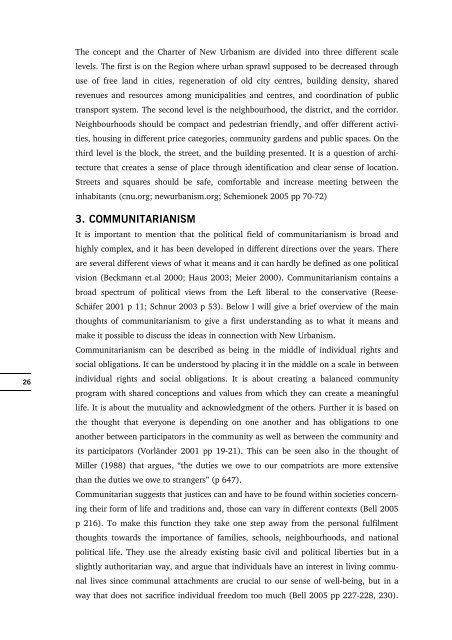


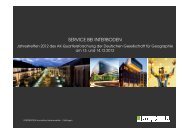



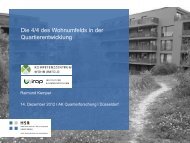
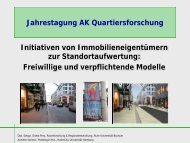
![Wohnen als soziale Kulturtechnik [â¦] (Stephanie Weiss)](https://img.yumpu.com/25621405/1/190x135/wohnen-als-soziale-kulturtechnik-a-stephanie-weiss.jpg?quality=85)
